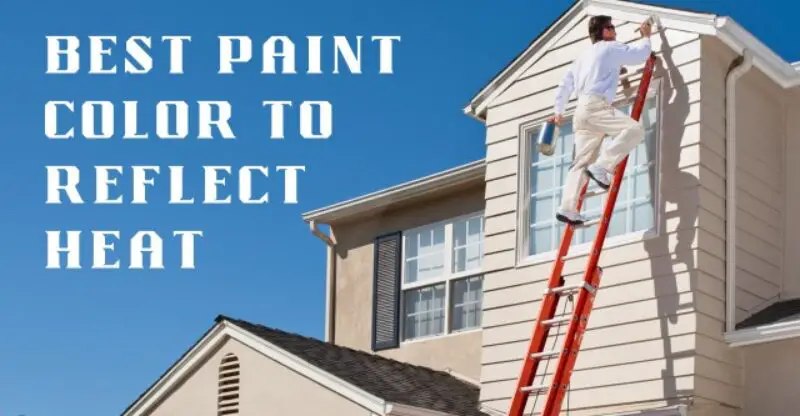Best Paint Color to Reflect Heat in Summer
Are you planning to give your home a new coat of paint this spring? Or maybe you’re looking for ways to reduce your energy bills? Either way, you’re in the right place.
Did you know that the color of your paint can help keep your home cool? That’s right – some colors can reflect heat and help you save on cooling costs.
The ability of paint to reflect heat plays a crucial role in maintaining comfortable indoor temperatures and reducing the need for excessive cooling.
The U.S. Energy Administration data says that we use up to 10% of our energy just for cooling our homes. For buildings, it’s even more – up to 40%.
Choosing the right paint color is not just about style, it is also about comfort and savings. In this article, we’ll explore the best paint color to reflect heat and keep your home cool in the summer. This could be the information you need to make your home more comfortable and energy-efficient.
What are Heat Reflective Paints and How They Work?
Heat-reflective paints are a specific type of paint designed to reflect more sunlight and heat than regular paints.
They’re designed with pigments and additives that help them bounce off solar radiation. This means that instead of the painted surface absorbing the heat, it reflects it.
But how does this work? These paints reflect parts of the solar spectrum, including infrared and ultraviolet rays. It helps to keep the underlying material cooler, reducing the heat inside your home or building.
According to a research paper on heat-reflective paints, these paints can significantly reduce the temperature of the painted surface, making your space more comfortable and energy-efficient.
So, if you’re looking to keep your home cool in the summer, heat-reflective paints could be a great option.
Best Paint Colors to Reflect Heat
Here’s a closer look at some of the best paint colors known for their ability to reflect heat effectively:
Teal and Green
Teal and green, particularly in lighter shades, are excellent at reflecting sunlight. Not only do these colors keep homes cool, but they also add a touch of nature-inspired beauty.
Perfect for sun-drenched areas, they maintain a comfortable indoor temperature. A recent study has shown that lighter shades can reflect more sunlight, reducing the amount of heat absorbed.
White and Off-White Colors
White reigns supreme as the most effective color at reflecting heat. According to studies, white roofs may reflect 50-90% of sunlight, substantially more than darker roofs, which reflect just 10-20%.
While off-white colors may not match the reflectivity of pure white, they still excel at bouncing back sunlight, ensuring a cooler home environment.
Light Shades of Blue
Light colors of blue, such as sky blue or powder blue, are not only visually appealing but also have excellent heat-reflecting characteristics. These colors efficiently reflect sunlight, thereby creating a cooler indoor atmosphere.
Data from the National Renewable Energy Laboratory indicates that lighter colors, including shades of light blue, reflect a higher percentage of sunlight compared to darker colors.
By bouncing back more sunlight, these colors reduce the heat absorbed by surfaces like walls or roofs, making them cool.
Pastel Colors
Soft pastel tones like light green or lavender effectively reflect heat while adding elegance to spaces. Perfect for those desiring a delicate and calming aesthetic, these colors prioritize both beauty and functionality.
According to the Cool Roof Rating Council, lighter colors can significantly reduce heat absorption and associated cooling costs.
Greys, Pastels, and Beige
Grey, pastel, and beige colors strike a balance between style and functionality, offering a neutral palette that complements various interior design styles.
While enhancing aesthetics, they also contribute to maintaining a cooler home environment. As highlighted by the U.S. Department of Energy, light-colored interior finishes play a vital role in reflecting sunlight, aiding in temperature regulation.
Benefits of Using Heat Reflective Paints
Using heat-reflective paints offers several advantages:
- Energy Efficiency: Using heat-reflective paints contributes to enhanced energy efficiency by reducing the reliance on air conditioning, which ultimately leads to lower energy bills.
- Extended Lifespan of Building Materials: Heat-reflective paints not only reflect solar heat but also block harmful ultraviolet (UV) radiation from penetrating building surfaces. This helps prevent UV-related damage to exterior finishes and extends the lifespan of building materials, such as wood, paint, and plastics.
3 Top Heat Reflective Paint Colors
Here are three top heat-reflective paint colors:
1. Rust-Oleum Heat Reflective Coating Paint Color
Rust-Oleum 301994 Roof Coating is white paint that’s impressive when it comes to reflecting heat. It starts with an 84% reflectivity rate, which is pretty high. But what’s even more amazing is that it keeps up a 74% reflectivity even after weathering.
So, if you’re looking for a paint color that’s great at reflecting heat and maintaining energy efficiency over time, this could be the one for you.
2. Dicor RP-IRC-1 CoolCoat White Paint
Have you considered Dicor’s CoolCoat Roof Coating for your heat reflection needs? This white, high-performance formula is not just a pretty face – it’s packed with ceramic microcells that can reduce heat transfer by up to 29%.
Imagine that! And it’s not just about keeping cool. It’s also about reducing the demand for your air conditioning and extending the life of everything under your roof.
3. KILZ Acrylic Exterior Heat Resistant Paint
KILZ Acrylic Paint is durable and resistant to scuffs, fading, and cracking, but it’s also ideal for hot climate areas to protect outdoor walls and roofs.
And if you’re after a bright, heat-reflective color, their Self-Priming Masonry, Stucco, and Brick Paint in Angel Wing/Bright White could be just what you need. Both paints offer excellent coverage and a smooth finish, making them great choices for heat reflection.
Environmental Impact
Aside from the benefits to building occupants, heat-reflective paints also have positive environmental implications:
- Sustainability: Many heat-reflective paints are formulated using environmentally friendly materials and manufacturing processes.
- Reduction of urban heat island effect: By lowering surface temperatures, these paints contribute to mitigating the heat island effect in urban areas.
Common Misconceptions
Despite their benefits, there are some common misconceptions about heat reflective paints, such as their limited color options or perceived effectiveness.
However, advancements in paint technology have addressed many of these concerns, offering a wide range of colors with excellent heat reflection properties.
Conclusion
Choosing the best paint color for optimal heat reflection is crucial when aiming to enhance energy efficiency and indoor comfort as a homeowner or building manager.
When deciding on a paint color, it’s essential to consider factors such as climate, building materials, and personal taste to make an informed choice.
Whether you opt for classic white or a soft pastel shade, the correct paint choice can significantly lower cooling costs and boost sustainability.
FAQs
White reflects heat the best because it reflects all wavelengths of light, including infrared light, which carries heat.
While heat reflective paints offer the most benefits in hot climates, they can also be beneficial in moderate or mixed climates by reducing the overall heat load on buildings.
Heat reflective paints are available in various sheen levels, including flat, satin, and semi-gloss, allowing you to choose the finish that best suits your aesthetic preferences.



